Article: A developer’s perspective on G.Mate’s YOPY Linux PDA
Feb 5, 2002 — by LinuxDevices Staff — from the LinuxDevices Archive — 4 viewsForeword: This is the eighth article in LinuxDevices.com's series on Exploring Linux PDA Alternatives by Jerry Epplin that explores the history, status, alternative architectures, and future developments of Linux on PDAs and handheld devices. In this installment, Epplin examines G.Mate's new Yopy Linux PDA, from both a user and developer point of view.
[Note: refer to this Yopy device profile for a detailed list of the Yopy's features and specs.]
Linux arrives on the palmtop
With the previous launch of the Sharp Zaurus, the large electronics manufacturers have confirmed the appropriateness of Linux as a platform for PDAs. Sharp's choice of Linux signals the market that operating systems from Microsoft and Palm are no longer the only acceptable choices. Previous Linux PDAs had been limited to Compaq's iPAQ, which is shipped with a Microsoft OS and had to be reloaded with Linux; and Agenda Computing's VR3, which seems to have been discontinued.
The new G.Mate Yopy continues the trend toward seriousness that the Zaurus started. As we shall see, it a serious PDA with world-class technical and design features that should appeal to consumers as well as developers, but with a few annoying failings.
“Take two”
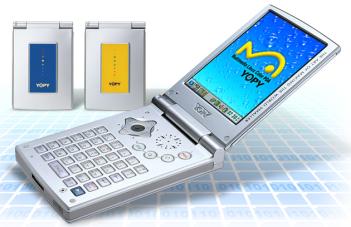 If you have been following the progress of Linux PDAs, you are aware of the circuitous route by which G.Mate arrived at the current Yopy. Last year they released a developer version of the Yopy — this was a boxy, plastic-looking unit approximately the color of your PC. It was also somewhat buggy, inevitably crashing within minutes of powering the unit up with its (otherwise nice) camera attachment. G.Mate also quickly developed a reputation for poor cooperation with interested Linux developers, especially in comparison to the remarkably open handhelds.org effort centered on the iPAQ. Some developers were put off by G.Mate's slow pace of releasing certain components of the system's software.
If you have been following the progress of Linux PDAs, you are aware of the circuitous route by which G.Mate arrived at the current Yopy. Last year they released a developer version of the Yopy — this was a boxy, plastic-looking unit approximately the color of your PC. It was also somewhat buggy, inevitably crashing within minutes of powering the unit up with its (otherwise nice) camera attachment. G.Mate also quickly developed a reputation for poor cooperation with interested Linux developers, especially in comparison to the remarkably open handhelds.org effort centered on the iPAQ. Some developers were put off by G.Mate's slow pace of releasing certain components of the system's software.
The original Yopy did have some promise, having a beautiful 16-bit display at a time when this was not common. Shortly after releasing the developer Yopy (and before I could write up a full review of it) G.Mate announced they were redesigning it for the consumer market. The current Yopy is the result of that redesign. Just to add one more distraction, recently G.Mate had to deny a well publicized rumor of the Yopy's demise.
A beautifully designed unit
One encounter with the new Yopy, and you will forget its long soap-opera history. This is a beautifully designed unit, with aesthetics beyond any Linux PDA around, including the Zaurus; as well as a mechanically solid feel — only the slightly cheesy yellow sticker on the front detracts from the aesthetics.
The new Yopy has several physical features that set it apart from most other PDAs. Most obvious is the clamshell form factor; the unit flips open, with the display on the top half and buttons on the bottom half. It is truly remarkable how thin, light, and compact G.Mate has succeeded in making the PDA using this form factor.
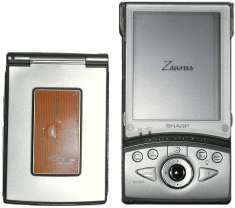
The Yopy is about the same weight and thickness as the Zaurus, but is slightly narrower (2.7 in. vs. 2.9 in.) and much shorter (4.0 in. vs. 5.4 in.). The clamshell form factor has the advantage of protecting the buttons from damage when the unit is closed. And keep in mind that most PDAs have screen protectors that the user must flip up before using the unit; thus no convenience is lost by the necessity of opening the unit before use.
The clamshell design also allows the Yopy to have the most usable keyboard around, at least among Linux PDAs. Having the display on the top half allows the entire bottom half to be allocated to input buttons (with a small space used for the speaker). The bottom two-thirds is occupied by a full keyboard.
An interesting keyboard
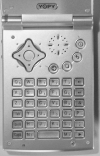
Some kind of keyboard is in my opinion a must for PDAs; handwriting recognition and pickboards simply cannot compete in my experience with simple pen and paper. The manufacturers seem to realize this — the Zaurus also has a keyboard.
Initial reports were that the Yopy keyboard would be of an “ABC” type — lots of hunting and pecking for touch-typists. But my unit has a QWERTY keyboard, albeit of a rather quirky type. The left hand keys are implemented on the top three rows, with the right hand keys in the bottom three (see closeup of keyboard).
The Yopy's keyboard most definitely requires some getting used to; but after less than five minutes of swearing I could enter text faster than I could on the Zaurus keyboard. When you consider that true touch-typing is not feasible on any PDA (absent one of those collapsible attached units) the most practical approach is to hold the unit in both hands and poke at it with your thumbs. Thus it matters little whether the left-hand and right-hand keys are adjacent vertically; this only affects your thumb placement. More important, this arrangement allowed G.Mate to increase the size of the keys, making poking at them much more accurate (compared to the Zaurus) for those with large thumbs or poor fine motor skills.
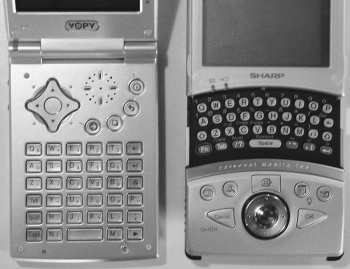
Comparing the Yopy and Zaurus keyboards
So on the whole I have to say G.Mate made good decisions on the Yopy's keyboard design. One complaint is that the keys are nearly flush with the surface of the unit, detracting somewhat from the utility gained by using larger keys. Of course, this design is necessitated by the clamshell form factor; protruding keys would impact the display when the unit is closed. Also, there is no way to input a “|” from the keyboard; you have to use the provided software-based pickboard.
Overall specs
The Yopy's specs put it solidly in the mainstream of today's higher-end PDAs. It has a 206 MHz StrongARM with 64MB of RAM and 16MB of flash. Its 16-bit display has a resolution of 240 x 320 pixels. The Yopy's I/O capabilities include an IrDA port, RS-232C, USB, a microphone, and a speaker. The serial port can only be accessed with a special connector.
Notably absent is a CompactFlash slot, though it does have a Multimedia Card slot for additional storage capacity. G.Mate has been a bit vague on this point, but the back of the unit slides off, revealing a proprietary I/O interface. G.Mate reports that they have in development CDMA, GSM, and GPRS modules. The positioning of the speaker and microphone, as well as the cellphone-like clamshell form-factor, suggest the possibility of the Yopy doubling as a mobile phone.
Inputs include the already-mentioned QWERTY keyboard, the four-way directional keypad that so many PDA makers seem to think is necessary, and up and down scroll buttons on the left side of the unit.
Hey, who stole my backlight?
By far the most annoying hardware characteristic of the Yopy is its lack of lighting for the display. By now, virtually all competing PDAs are frontlit or backlit in some way. I am at a loss as to how G.Mate thought they could do without such a basic essential feature.
The Yopy is virtually unusable under any lighting conditions that are less than ideal. I found myself contorting into all sorts of strange positions in the evening to get the best light from the nearest lamp — in this I had to compete with my GameBoy-playing kids for space. A few minutes of this had me reaching for my Zaurus.
Suffice to say that a $400 PDA must have its own lighting. The Yopy has a beautiful display — G.Mate should make it visible. When I asked about G.Mate's plans to address the issue, a G.Mate representative answered, without being specific, “we will improve it.”
The touchscreen on my unit is also a bit shaky; sometimes it registers well to the left of where the stylus is placed, jumping wildly horizontally.
How to use and not lose the stylus
Another annoying — though much less serious — problem concerns the stylus, by far the strangest one I've encountered. This is an elaborate telescoping device with a cap. It is rather thick, and the Yopy has no place to store it when not in use. So I suppose the workflow would go something like this:
- Pull out the Yopy from wherever you keep it.
- Pull out the stylus from wherever you keep it; unlikely to be the same place, since it's smaller.
- Yank the cap off the stylus. I don't know what to do with the cap now. It has a tether, so I suppose you keep it looped around your finger.
- Extend the telescoped stylus.
- Work. If you need to use the keyboard, set the stylus down. It is cylindrical, so it rolls away.
- Reverse the above when finished.
Not to worry, though. You'll probably lose the stylus soon enough and end up using the cap from a BIC pen as a replacement.


Yopy's stylus closed . . . and extended
Again, I'm not sure what G.Mate was thinking with this stylus design. It's a great little mechanical device; it's just not practical. As of this writing I still haven't lost mine, but I've had several close calls.
Software environment
It is hard to argue with G.Mate's choices for the Yopy's software environment; though, like the hardware, they came to the current design by a circuitous route. Originally they used something call W Windows, a windowing system with a client/server architecture like that of X, but more lightweight (and incompatible). As they always do in such situations, Linux developers screamed for X, and G.Mate now provides it on the Yopy.
In addition, the IceWM window manager runs on top of X to round out the GUI environment. GTK+ libraries are available, and most applications provided with the Yopy make use of them. So X applications, and especially GTK+ apps, should port easily. I'm a Qt-on-top-of-the-framebuffer man myself because X seems like an extravagance on a resource-constrained device, but one cannot deny that it works for the Yopy; and adding an MMC card should ensure that even larger apps can be supported, especially with the generous RAM provided.
Applications
The Yopy comes with a fairly ordinary complement of applications.
The browser is something called DeviceMosaic, by OpenTV. It has gnotepad+ for editing text files, though I was happy to find that opening an xterm and running vi works just fine using the keyboard. One annoyance is that keypresses don't auto-repeat — pressing, say, the down arrow (or 'j' in vi) moves the cursor down only one line; multiple lines require multiple keypresses. Strangely, this is not true of the pickboard, which does auto-repeat. Also, the 'Shift' key behavior is unintuitive; you press it and release it, then the next letter pressed is capitalized. It does not work to hold it down while typing multiple letters — only the first one will be capitalized.
A task manager, contact list, schedule manger, and calculator are provided. An MP3 player and recorder are included. The only games provided by default are Freecell and Solitaire. GNU Paint is provided for drawing. At any rate, this is an open source platform — if you don't like the software as provided, change it.
Yopy Desktop
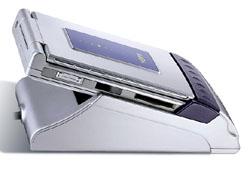
The Yopy Desktop is an application intended for synchronizing your PIM applications with your PC — as on the Zaurus, this facility is Windows only. I don't know why the Linux PDA manufacturers insist on annoying Linux developers and users in this way. Using a cross-platform toolkit and making use of the USB facilities in Linux should have made supporting both platforms a straightforward exercise. If the manufacturers won't provide a Linux version of their apps, they should at least release the source so someone else can. In any case, G.Mate reports that they plan to release a Linux version but at the moment there are “more urgent things to be done”.
Incidentally, the Yopy Desktop syncing utility has a penguin performing various tasks as images on its buttons. He's cute, but as far as I'm concerned this just adds to the inherent irony of a Windows-only program for syncing with a Linux-based PDA.
At any rate, after some grumbling I installed the Desktop on a Windows 2000 computer. Win2K failed to recognize the Yopy when connected to the USB port. A check of the web forum and Yahoo mailing list reveals at least one other user with the same problem. As of this writing no solution has been posted; and my tolerance for balky closed Windows code is quite low, so I won't be spending any more time trying to get it to work.
Something called CompanionLink is also provided for synchronizing with Microsoft Outlook or Lotus Notes. You will have to read a review of these proprietary Windows-based facilities elsewhere.
Growing a developer community
As I mentioned earlier, a minor controversy surrounded the release of the earlier developer version of the Yopy. Some developers found G.Mate less than helpful and cooperative in their support.
One of the great attractions of Linux for PDA manufacturers is the intense interest generated among Linux developers when a new Linux PDA is released; inevitably a flood of applications are soon developed or ported to the new hardware. We saw this with the iPAQ, the VR3, and the Zaurus — all of which succeeded in generating considerable buzz among programmers, at least until the next big thing arrived.
But success in generating interest depends on providing excellent support to the developer community; and it is still not clear that G.Mate fully understands this, though they have certainly improved in this area since the release of the developer unit.
The Yopy developer community is much smaller than those generated by the releases of the iPAQ, VR3, and Zaurus. In part, this is undoubtedly because G.Mate wasted considerable goodwill by its handling of the original Yopy; some developers are probably reluctant to take a second look, especially because excellent alternative Linux PDAs are available. Also, the Yopy developer website is weak, having out of date and contradictory information; among other things, the FAQ section reports the Yopy still using W Windows, and the Linux kernel as 2.2 (my unit has 2.4.2), though one can find the correct information elsewhere. Documentation provided is sparse, especially in comparison to Sharp's Zaurus developer website, which contains excellent documentation on every level of Zaurus development.
Conclusion
With a little more effort, the Yopy could be very competitive with the other Linux PDA alternatives. It is an almost entirely open source software platform, with apparently only the pen input and the browser provided under proprietary licenses. These could quite easily be replaced with open source alternatives.
Beyond that, their problems are primarily in public relations; they need to show they have an understanding of the developer community and a committment to supporting it. G.Mate would do well to take cues from both Sharp and Compaq on how to support an open source development community.
Oh, and a backlit display. Did I mention the Yopy needs a backlit display?

About the author: Jerry Epplin has written embedded software for the past fifteen years, primarily for medical devices. He can be reached at [email protected]
The following articles may also be of interest . . .
This article was originally published on LinuxDevices.com and has been donated to the open source community by QuinStreet Inc. Please visit LinuxToday.com for up-to-date news and articles about Linux and open source.